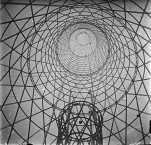Known Unknown Shukhov

This year the Shukhov Tower, which is called one of the most prominent feats of engineering, has celebrated its 95th anniversary. The Radio Tower at Shabolovka is not only a symbol of Soviet radio and television broadcasting, it is also a world-known monument to the Russian avant-garde architecture and the most renowned construction by engineer Shukhov.
Shukhov is regarded as the founder of mathematic modeling of diagonal grid structures. Since his early childhood the future architect showed impressive mathematic skills, for instance, in the 4th grade he found a new proof of the Pythagorean theorem.
Vladimir Shukhov graduated from a high school with a gold medal, and what is more important, with clear understanding of what he wanted to do in life. Being keen on exact science, the young man already knew that he would become an engineer. In his childhood he displayed zeal for designing when he built a fountain near his house and a small water mill on a brook…
Apart from that, this profession was extremely popular in those years and had certain glamour. The industrial revolution that took place in Russia in the last decades of the 19th century resulted in the construction of factories, plants, railways, bridges and many other edifices of public importance all over the country. A good engineer was supposed to invent something new instead of repeating what was already known. It was essential to work at the borderline of technical “genres” and this required not only encyclopedic knowledge but also unconventional and sometimes even surprising thinking and particular technical intuition.
Full content of this issue you can read here
The full version of the article can be read in our printed issue, also you can subscribe to the web-version of the magazine
 Text by Nina Konovalova
Text by Nina Konovalova


